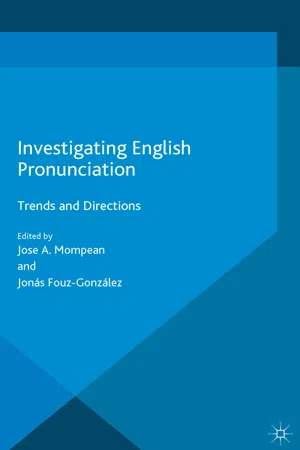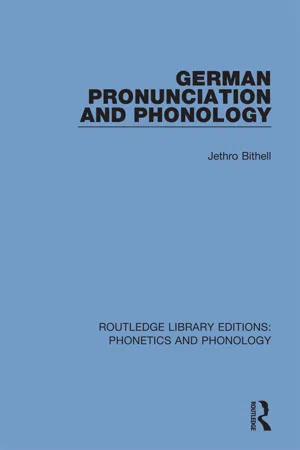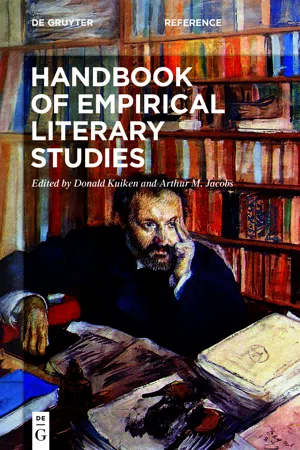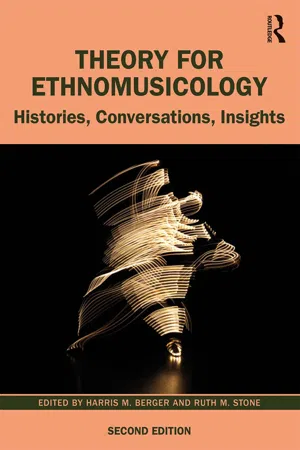Languages & Linguistics
Sound Symbolisms
Sound symbolisms refer to the phenomenon where certain sounds are associated with specific meanings or emotions across different languages. This concept suggests that there is a non-arbitrary relationship between sound and meaning, and that certain sounds may convey universal or cross-linguistic associations. Sound symbolisms can be found in onomatopoeic words, ideophones, and other linguistic elements.
Written by Perlego with AI-assistance
4 Key excerpts on "Sound Symbolisms"
- eBook - ePub
Investigating English Pronunciation
Trends and Directions
- Jose A. Mompean, Jonás Fouz-González, Jose A. Mompean, Jonás Fouz-González(Authors)
- 2015(Publication Date)
- Palgrave Macmillan(Publisher)
Sound symbolism can be defined as the relationship established between the acoustic elements in a word and its meaning component. Sound symbolism is therefore based on the motivated relationship between form and meaning, and is consequently opposed to the structuralist arbitrariness of the linguistic sign (Saussure, 1983). Neglected for a long time, sound symbolism is nowadays attracting researchers’ attention. According to Hinton, Nichols and Ohala (1994), sound symbolism can be classified into four basic types: corporeal, imitative, conventional and synaesthetic.The first type, corporeal, is defined as the one taking place when the speaker makes a certain sound in order to express a physical or emotional state (e.g. yawning when bored). The second type of sound symbolism, imitative, is also commonly referred to as auditory iconicity or onomatopoeia. This type takes place when the speaker uses linguistic elements to imitate non-linguistic sounds (e.g. woof-woof for a dog’s bark). The third type is conventional sound symbolism, also known as associative iconicity or, most commonly, phonaes-thesia. It can be described as the analogical relation established between a sound or sound cluster and a given meaning (e.g. the consonant cluster /fl-/ appears in words denoting a type of ‘movement in air’, as in flow, flit, flutter). The fourth type discussed by Hinton et al. is synaesthetic sound symbolism, also known as cross-modal iconicity. This type implies the use of acoustic elements to refer to non-acoustic phenomena. A very common example is the widely known association between the invented words takete and maluma and spiky and rounded figures respectively (Köhler, 1929), later replicated with the words kiki and bouba (Ramachadran and Hubbard, 2001a). This last type of sound symbolism is perhaps the one that is nowadays experiencing a major research effort (see e.g. Beeli, 2007; Beeli, Esslen and Jäncke, 2005; Westbury, 2005), as described in the next section.11.2.2 SynaesthesiaAs mentioned above, synaesthetic sound symbolism implies the presence of something in the form of the object observed that triggers an association with the sound. More generally, synaesthesia is the involuntary automatic physical experience of cross-modal association, in which one sense triggers off an additional perception in a different sense or senses. For example, a synaesthete not only sees the colour red, but might smell - eBook - ePub
- Jethro Bithell(Author)
- 2018(Publication Date)
- Routledge(Publisher)
CHAPTER ISOUNDS, SYMBOLS AND ALPHABETS
MEANS OF CONVEYING MEANINGPronunciation. Language (in the general significance of the word) is made up of sounds. The pronunciation (Aussprache) of a given language is the way in which the sounds of this language are made. They are made by the organs of speech; and they are made to express, and usually to convey, a meaning. Meaning may be expressed by speech without being conveyed to a hearer (for instance, when one speaks or reads to oneself); it is conveyed when it is apprehended by the ears of a second person or of other persons.Language (Sprache) has two meanings. It means (1) language in general, that is, the faculty of speech as distinguished from silence, the power of speech, 1 and (2) any individual language as the mode of expression, by words and the arrangement of words, of any one nation as distinguished from the languages of other nations.Etymologically ‘language’ (<Fr. langage <langue) means that which is produced by the tongue;2 but language’ has been extended to mean that which is conveyed by signs: thus ‘finger language’ or ‘finger and sign language’ is the means of expression of deaf and dumb people (Fingersprache der Taubstummen). The language of animals (die Sprache der Tiere, die Tiersprache) consists of inarticulate or inconglomerate sounds; that is, sounds not divisible into syllables and words. The language of flowers conveys meaning by treating flowers as symbols; that is, by ascribing to them a fixed and separate meaning. Meaning may also be conveyed by gestures (Gebärdensprache)3 - eBook - ePub
- Donald Kuiken, Arthur M. Jacobs, Donald Kuiken, Arthur M. Jacobs(Authors)
- 2021(Publication Date)
- De Gruyter(Publisher)
u as darker” has received cross-linguistic support (Moos et al., 2014; Tsur, 1992, 1997; Wrembel, 2009; but see Kraxenberger & Menninghaus, 2016b). Furthermore, there is evidence indicating that some acoustic and phonological features iconically express the size of denoted objects (Huang et al., 1969; Sapir, 1929; Thompson & Estes, 2011) and their (e. g., angular vs. round) shape (Köhler, 1929; Ramachandran & Hubbard, 2001; Westbury, 2005). Of course, these sound-symbolic biases of language may be more fully developed and more extensively exploited in carefully constructed literary texts.Poetry, being firmly rooted in oral traditions, is the literary genre in which such sound-iconic relations have been studied most extensively (Fónagy, 1961; Jakobson & Waugh, 1979/2002; Jespersen, 1933; Tsur, 1992), following the notion that its sound “must seem an echo to the sense” (Pope, 1711/2010). In modern literary theory, the school of (Russian) structuralism was the first to highlight the phonological and phonetic aspects of literary texts, especially of poetry, which was claimed to be “a province where the internal nexus between sound and meaning changes from latent into patent and manifests itself most palpably and intensely” (Jakobson, 1960, p. 373). Interestingly, phono-semantic iconicity in verse appears not to be restricted to individual sound-iconic words; rather, the meaning of one word may also be sound-iconically reflected in the phonetic properties of adjacent words in the same line (Auracher et al., 2019).The relation between the sound of a poem and its emotional meaning has been frequently highlighted in theoretical reflections as well as empirical studies (e. g., Jakobson & Waugh, 1979/2002; Tsur, 1992). Indeed, most empirical studies on (phonological) iconicity in poetry have focused on readers' perceptions and assessments of a poem's key emotional tonality (e. g., Aryani, et al., 2016; Auracher et al., 2010; Kraxenberger & Menninghaus, 2016a, 2017; Kraxenberger, 2017; Whissell, 2002, 2011). Hevner (1937), for instance, examined the connotations of vowels (high front vowels vs. round back vowels) and basic rhythmic patterns in poetry (iambs and anapests), asking listeners to describe carefully constructed nonsense verse by choosing appropriate adjectives from a 64-item list. She observed that “meter is very effective in determining the happiness or sadness of the poetry, while vowel sounds are quite ineffectual in this capacity” (p. 431); iambs were perceived as being solemn, serious, earnest, sad, heavy, dignified, etc., whereas anapests were described as merry, humorous, playful, joyous, light, gay, etc. (for a further investigation of prosodic aspects of language in relation to emotion perception, see Kraxenberger et al., 2018). - eBook - ePub
Theory for Ethnomusicology
Histories, Conversations, Insights
- Harris Berger, Ruth Stone(Authors)
- 2019(Publication Date)
- Routledge(Publisher)
13Until the 1990s, structural linguistic approaches to music analysis were relatively common. In many cultural traditions, there are musical sounds that retain relatively stable meanings and seem to operate in parallel to the semantic function of words; as such, some musical systems appear to have something like the referential function of language and operate as a “speech surrogate” (Stern 1957). George Herzog’s documentation of Liberian drum languages (1934, 1945) is one example of ethnomusicological work that takes this approach. Similarly, scholars in musicology and music theory have analyzed musical motifs and harmonies, such as Wagnerian leitmotifs , as referring to particular kinds of extramusical meanings (Meyer 1960; Hacohen and Wagner 1997). However, this apparent referential function in music differs distinctly from that of language, because language can, through its metalinguistic function, be used to discuss, frame, or refer to other linguistic phenomena (e.g. in reported speech or word definitions) and does so in ways that do not have a direct parallel in musical communication—at least without resorting to language as a mediating communicative system. Another adaptation of the music/language analogy was through the analysis of underlying musical structures as a kind of syntax. One notable example is Robin Cooper’s application of Chomsky’s notions of deep structure and generative grammar to the raga system found in Indian classical musics (1977). In those traditions, the system of ragas allows the musician to generate melodies, in part, by drawing on a set of melodic modes. These modes systematically govern the relationships among tones and musical phrases, providing the listener with a way to determine which composition is being performed at any given time (e.g. Rag Bhairavi or Rag Yaman) and whether it is being performed correctly, accurately, and/or appropriately.14
Index pages curate the most relevant extracts from our library of academic textbooks. They’ve been created using an in-house natural language model (NLM), each adding context and meaning to key research topics.
Explore more topic indexes
Explore more topic indexes
1 of 6
Explore more topic indexes
1 of 4



